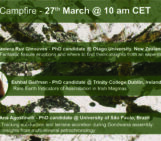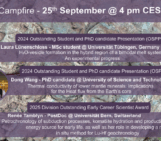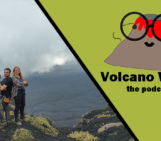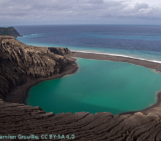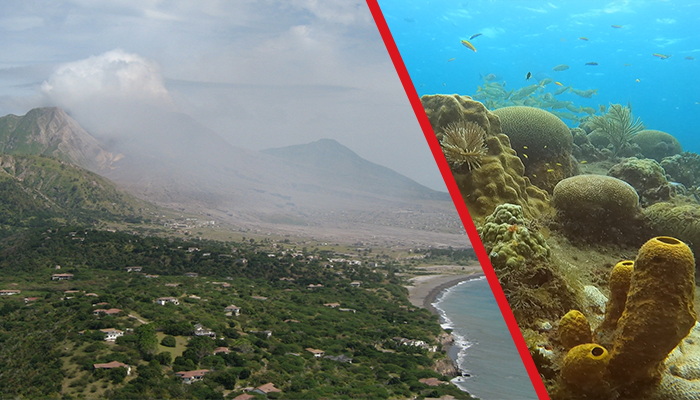
What can corals tell us about volcanic eruptions? Is it possible corals, in the span of their lives, have recorded valuable data on volcanic eruptions they have witnessed? Today we find it out together with Prof. Tom Sheldrake, who takes us on a journey through coral reefs and volcanic eruptions, giving voice to what corals want to tell us about volcanic activity!
Introducing Professor Tom Sheldrake and his research
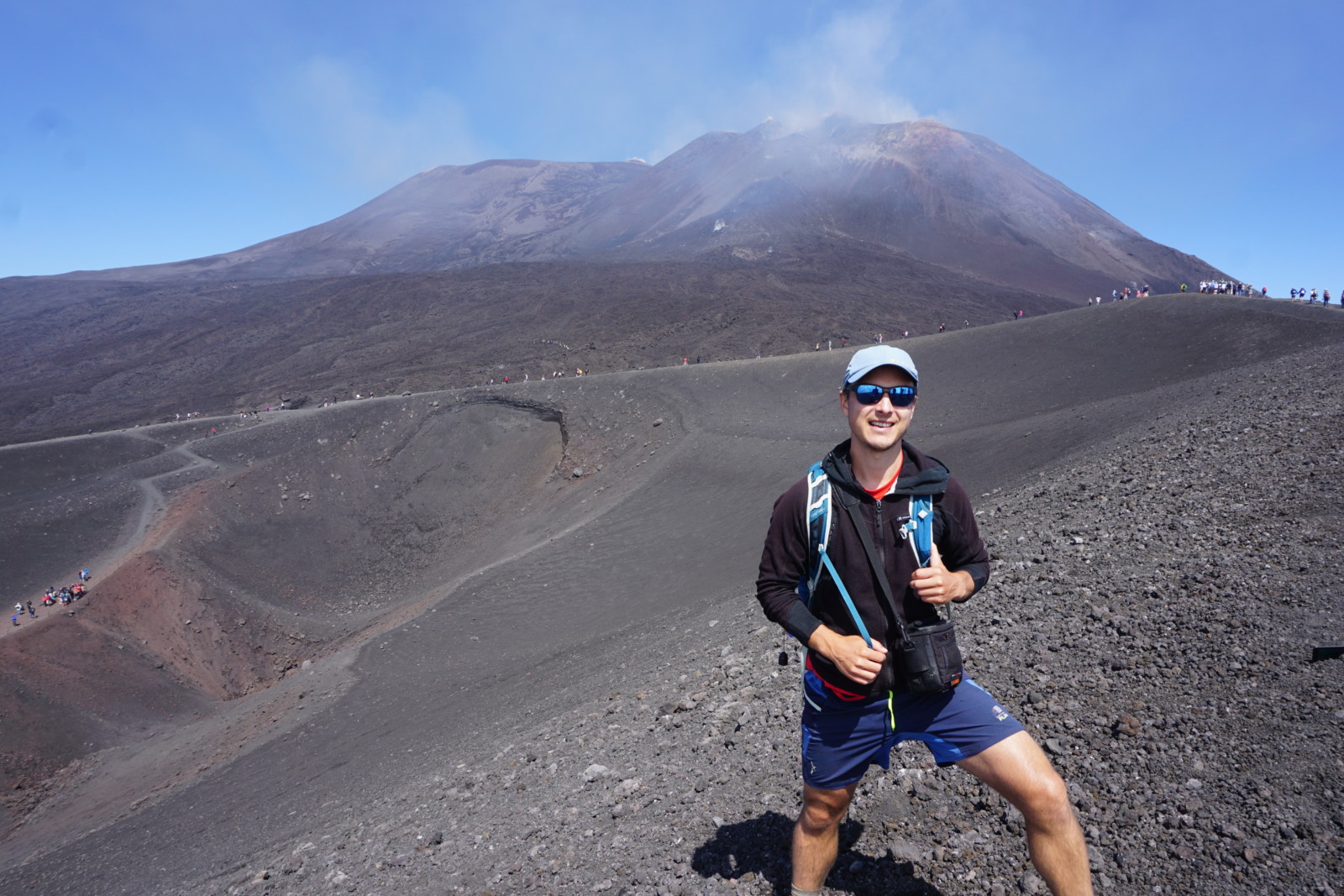
A picture of Prof. Tom Sheldrake on Mt. Etna
Prof. Tom Sheldrake earned his Honours Master of Arts (MA) degree in Geography and Economics from University of Edinburgh and his Master of Research (MRes) degree in sciences of natural hazards from University of Bristol. He obtained his PhD from the University of Bristol, with a thesis entitled “Potential of exchangeability for understanding magmatic processes and forecasting eruptive activity”. In this project he used Bayesian network and hierarchical models to determine in which circumstance observation and information acquired from different volcanoes can be exchangeable and used to asses volcanic risk and hazard. After a post-doctoral project at the University of Bristol, on the potential impact of volcanic eruption on power generating facilities and one at the University of Geneva on statistical analysis of volcanic datasets, he won an SNSF Eccellenza Professorial Fellowship with the project GEOVOLCO, and is now leading an innovative research group which studies, both in situ and experimentally, how corals are able to record the chemical and physical changes that occur in their environment during their growth.
Inside GEOVOLCO‘s activities: between volcanic eruptions and coral reefs
Hi Tom, thank you a lot for joining us today! I am quite thrilled to discover together with the readers more about the hidden information in corals. before delving into the detailed aspects of your research, can you introduce us to the GEOVOLCO project? What is it about?
Sure, the principal aim of GEOVOLCO is to understand the effects of volcanic eruptions on shallow marine environments where corals are found, to understand the impact that volcanic ash deposition and dissolution may have on the physiology of corals, and to investigate whether these changes imprint a signature within the biomineralized skeleton of a coral. Corals have long been used to reconstruct long-term environmental changes, and the GEOVOLCO project aims to exploit advances in in-situ analytical techniques to develop high resolution chronologies of coral skeletons in active volcanic regions.
How can corals gather information of volcanic activity, and what tools do we have to be able to read this information?
This is the fundamental question and we have some ideas about how this may occur. The first is that the corals are able to incorporate the ash particles into the skeleton directly. This would be excellent as we would be able to sample the ash directly. The pathway of this incorporation process is not clear, but there is evidence that microplastics are found in coral skeletons so there is no reason why it would not be the same for ash particles. We have observations of the corals ingesting ash particles (see video below), and it is our aim to investigate this in more detail. An alternative mechanism would be the leaching of chemical elements that are found on the surface of freshly erupted ash particles. This could change the composition of the seawater from which the skeleton is precipitated, especially if these particles are ingested and leached within the coral organism. Then, by analysing the composition of the skeleton using mass spectrometry we would hope to see localised signals where certain chemical elements associated with magmatic systems are enriched.
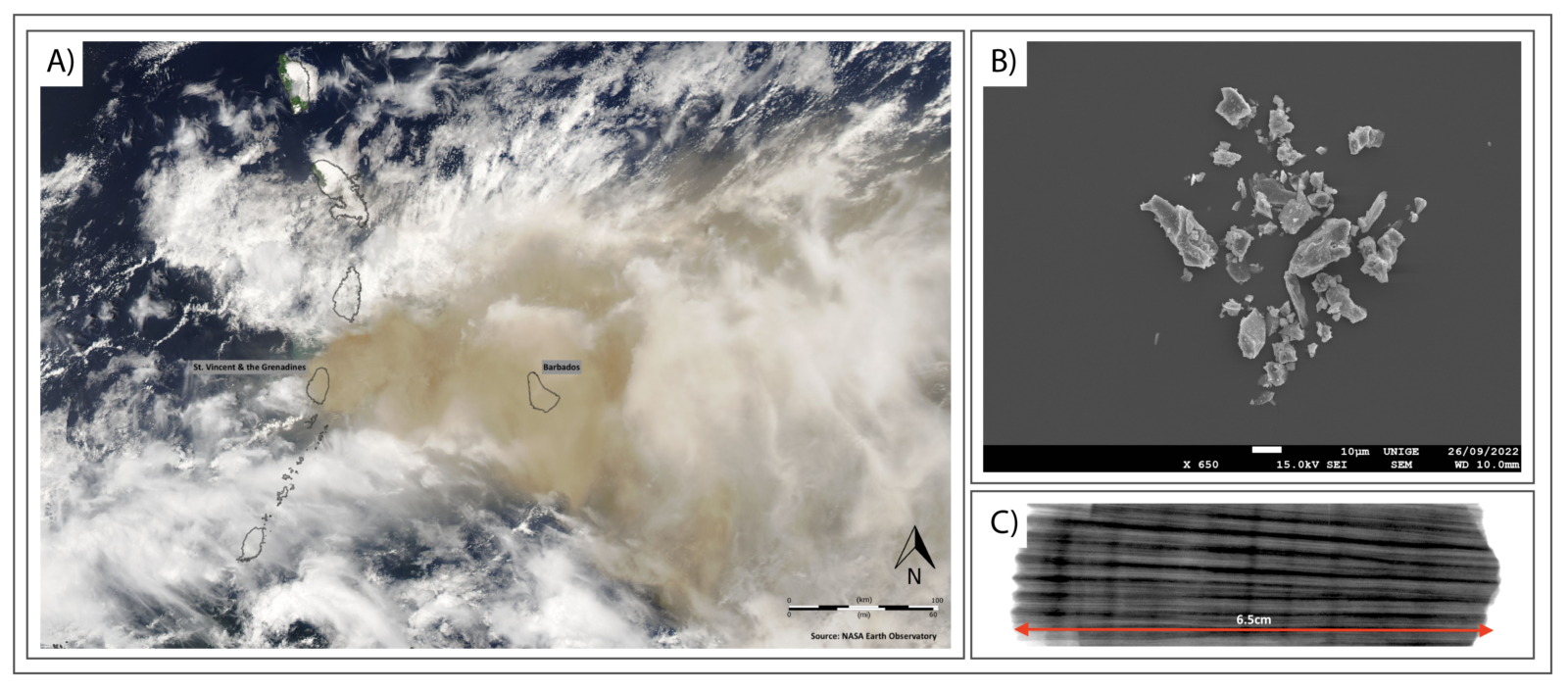
A) MODIS imagery of the Eastern Caribbean region, showing the dispersion of volcanic ash (brown colour) over hundreds of kilometres to the east of St. Vincent. Image taken from Nasa Earth Observatory. B) Secondary electron image of ash particles deposited on Barbados taken by Isabelle Beney. Volcanic ash provided by Dr. John Mwanza. C) X-ray image of a coral core samples from Barbados, with cyclicity in density representing annual periods.
Corals are going through an ongoing process of degradation, even more fuelled by the side effects of climate change but also (and maybe even more) by direct anthropogenic activity such as commercial coral extraction and tourism (Aronson et al., 2003; Cheal et al., 2017; Gazi et al., 2020). for these reasons I imagine that a great effort is and should be made to safeguard coral reefs. In this context, what impact does the study and sampling of corals in-situ have on coral reef life? Is it a type of analysis that can be carried out without major impacts on reef life? What precautions need to be taken by those who, like you, decide to work with corals?
Indeed, with the current warming of the ocean corals are susceptible to a process known as bleaching. This is where the symbiotic algae, known as zooxanthellae, are ejected by the host coral organism. These zooxanthallae are fundamental to the health of the coral, and via photosynthesis they produce energy that can be consumed by the coral for metabolism and processes such as biomineralization. It is these symbionts that give a coral it’s colour, and without them a coral organism cannot survive for very long. Additionally, as you suggest, anthropogenic impacts can also reduce coral health by a variety of pathways, such as increased pollution, which can impact the coral species directly as well as the general health of the reef ecosystem. We are particularly aware of these issues and so we work closely with organisations involved in marine coastal management and reef restoration, to ensure we do not exacerbate the degradation of coral reefs. When sampling corals we take what are known as coral cores. The coral skeleton is not an active part of the coral organism, so removing the core has not impact on the organism. We do have to remove some tissue to take the coral core, but by plugging the hole that is left by the core we provide a substrate for the coral to recolonise that allows it to continue growing as it was before we took the core.
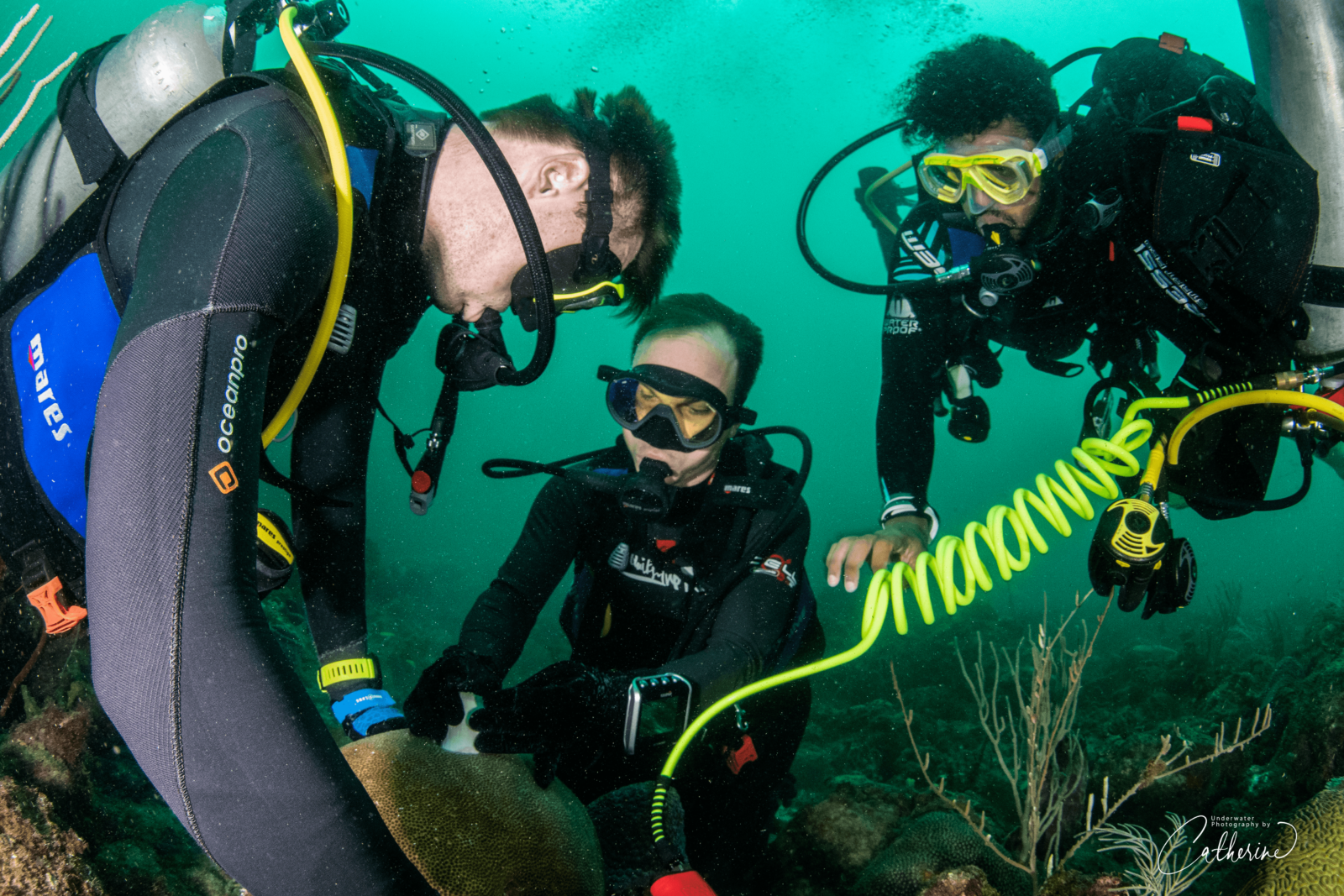
Sampling a skeletal core from a coral located off the coast of Barbados that experienced ash fall during the 2021 La Soufrière eruption on St. Vincent. This is performed in collaboration with the Coastal Zone Management Unit of Barbados, who accompanied us during the fieldwork. Once the coral is removed the cavity is filled with a concrete plug, on which the coral will recolonise. Photo taken by Catherine Holmes.
What implications do you think your study may have in the future in terms of both the understanding of past and future eruptions and volcanic risk assessment?
Many coral reefs are found in tropical regions, where terrestrial preservation of eruptive units is poor, especially for smaller magnitude events. This means the eruptive record for these events is often incomplete and estimating their frequency of occurrence becomes difficult. Whilst certainly not the most destructive volcanic events outright, these low magnitude high frequency events are often the most hazardous for local populations and difficult to manage. My hope is that the coral record can help complement the terrestrial record of volcanic eruptions, and provide a chronology at a resolution that is relevant for decision-making timescales for these smaller magnitude events.
We have talked until now about the great contribution corals can provide us in understanding volcanic activity, but one question that comes to mind is, what is the impact of volcanic activity on coral reef life?
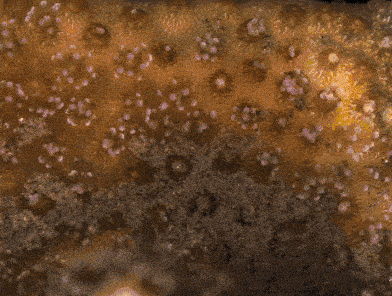
A GIF of ash settled on the surface of a cultured sample of Stylophora pistillata, in which ash is removed from the surface and also ingested by coral polyps. This video was taken using a Zeiss Axio Zoom V16 microscope at the Centre Scientifique de Monaco by Frank Förster.
As I hinted to at the beginning of our discussion, we are also interested in how the deposition of ash can impact coral physiology. It has been observed that in close proximity to an eruption, where large amounts of ash are deposited and pyroclastic flows and lahars may enter the sea, that corals can become smothered. Corals do have the ability to clean themselves using a combination of mucus and cilia, but under heavy deposition this process is inefficient and the corals will die. As we move further away from the volcano, however, this effect can be reversed and the ash may have a positive effect by providing nutrients for processes such as photosynthesis that are otherwise limited in the ocean. We are investigating these effects by performing some aquarium experiments with colleagues at the Centre Scientifique de Monaco. This topic in itself is really interesting for understanding how volcanism may impact the long-term development and resilience of corals reefs. But additionally, any changes in physiology will likely impact the biomineralization process and thus change the chemical composition of the coral skeleton that is precipitated. Consequently, in combination with the mechanisms and observations we discussed previously, such changes could also be useful markers to identify the past record of volcanic eruptions in corals.
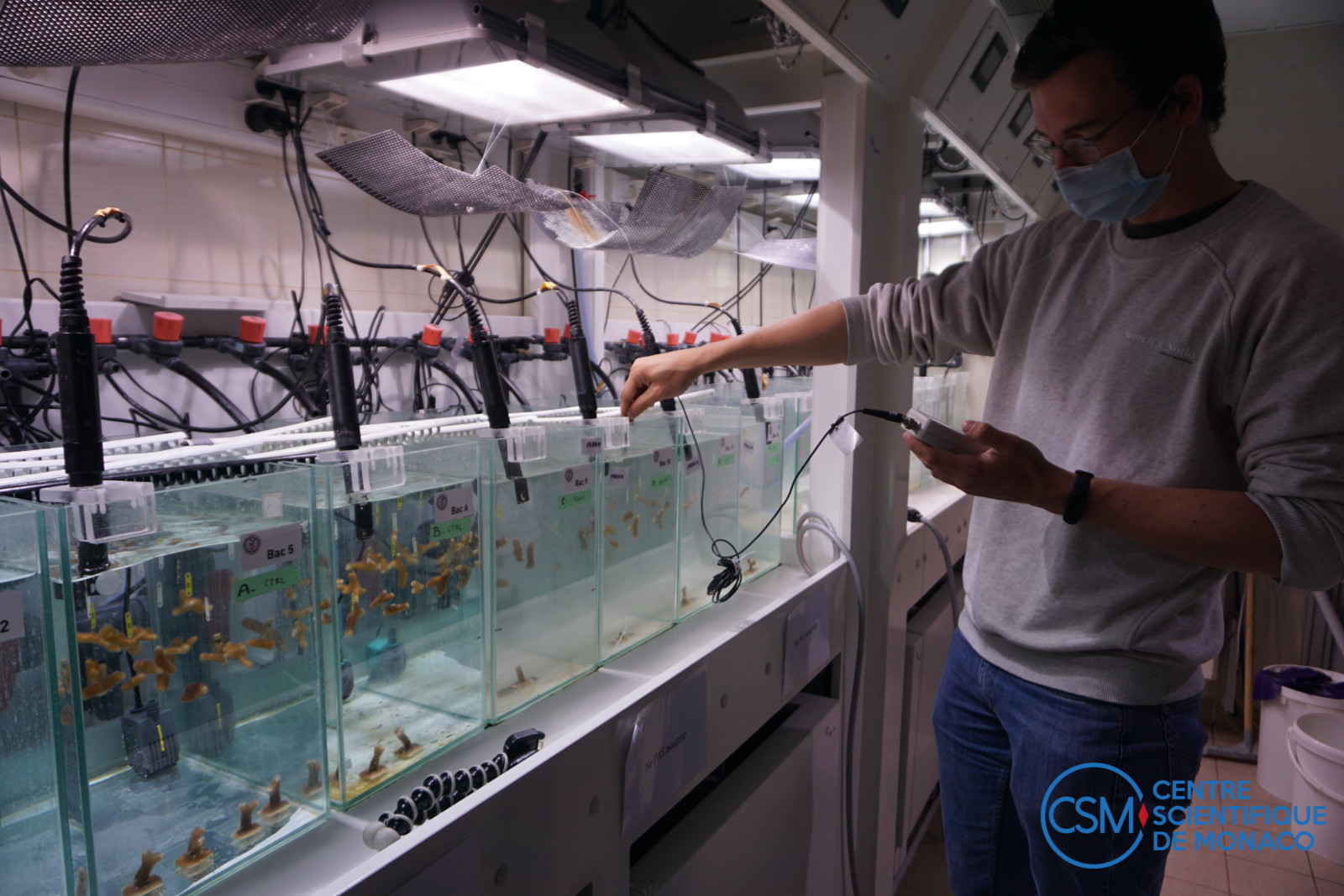
Aquaria at Centre Scientifique de Monaco used to investigate the physiological impact of volcanic ash of corals.
References
- Aronson, R. B., Bruno, J. F., Precht, W. F., Glynn, P. W., Harvell, C. D., Kaufman, L., … & Valentine, J. F. (2003). Causes of coral reef degradation. Science, 302(5650), 1502-1504.
- Cheal, A. J., MacNeil, M. A., Emslie, M. J., & Sweatman, H. (2017). The threat to coral reefs from more intense cyclones under climate change. Global change biology, 23(4), 1511-1524.
- Gazi, M. Y., Mowsumi, T. J., & Ahmed, M. K. (2020). Detection of coral reefs degradation using geospatial techniques around Saint Martin’s Island, Bay of Bengal. Ocean Science Journal, 55, 419-431.
- GEOVOLCO project, Department of of earth sciences, University of Geneva, Switzerland. Volcanoes and the environment research group. The team and the projects.

